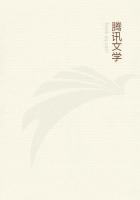The cells in question were divided into three storeys by partitions of green mortar; the lower storey was occupied by a female, the two others by males, with smaller cocoons.
I came to an even more remarkable example. Two Anthidia of my district, A. septemdentatum, LATR., and A. bellicosum, LEP., adopt as the home of their offspring the empty shells of different snails:
Helix aspersa, H. algira, H. nemoralis, H. caespitum. The first-named, the Common Snail, is the most often used, under the stone-heaps and in the crevices of old walls. Both Anthidia colonize only the second whorl of the spiral. The central part is too small and remains unoccupied. Even so with the front whorl, the largest, which is left completely empty, so much so that, on looking through the opening, it is impossible to tell whether the shell does or does not contain the Bee's nest. We have to break this last whorl if we would perceive the curious nest tucked away in the spiral.
We then find first a transversal partition, formed of tiny bits of gravel cemented by a putty made from resin, which is collected in fresh drops from the oxycedrus and the Aleppo pine. Beyond this is a stout barricade made up of rubbish of all kinds: bits of gravel, scraps of earth, juniper-needles, the catkins of the conifers, small shells, dried excretions of Snails. Next come a partition of pure resin, a large cocoon in a roomy chamber, a second partition of pure resin and, lastly, a smaller cocoon in a narrow chamber. The inequality of the two cells is the necessary consequence of the shape of the shell, whose inner space gains rapidly in width as the spiral gets nearer to the orifice. Thus, by the mere general arrangement of the home and without any work on the Bee's part beyond some slender partitions, a large room is marked out in front and a much smaller room at the back.
By a very remarkable exception, which I have mentioned casually elsewhere, the males of the genus Anthidium are generally larger than the females; and this is the case with the two species in particular that divide the Snail's spiral with resin partitions. I collected some dozens of nests of both species. In at least half the cases, the two ***es were present together; the female, the smaller, occupied the front cell and the male, the bigger, the back cell. Other cells, which were smaller or too much obstructed at the back by the dried-up remains of the Mollusc, contained only one cell, occupied at one time by a female and at another by a male. A few, lastly, had both cells inhabited now by two males and now by two females. The most frequent arrangement was the simultaneous presence of both ***es, with the female in front and the male behind. The Anthidia who make resin-dough and live in Snail-shells can therefore alternate the ***es regularly to meet the exigencies of the spiral dwelling-house.
One more thing and I have done. My apparatus of reeds, fixed against the walls of the garden, supplied me with a remarkable nest of the Horned Osmia. The nest is established in a bit of reed 11 millimetres wide inside. (.429 inch--Translator's Note.) It comprises thirteen cells and occupies only half the cylinder, although the orifice is plugged with the usual stopper. The laying therefore seems here to be complete.
Well, this laying is arranged in a most singular fashion. There is first, at a suitable distance from the bottom or the node of the reed, a transversal partition, perpendicular to the axis of the tube.
This marks off a cell of unusual size, in which a female is lodged.
After that, in view of the excessive width of the tunnel, which is too great for a series in single file, the Osmia appears to alter her mind. She therefore builds a partition perpendicular to the transversal partition which she has just constructed and thus divides the second storey into two rooms, a larger room, in which she lodges a female, and a smaller, in which she lodges a male. She next builds a second transversal partition and a second longitudinal partition perpendicular to it. These once more give two unequal chambers, stocked likewise, the large one with a female, the smaller one with a male.
>From this third storey onwards, the Osmia abandons geometrical accuracy; the architect seems to be a little out in her reckoning.
The transversal partitions become more and more slanting and the work grows irregular, but always with a sprinkling of large chambers for the females and small chambers for the males. Three females and two males are housed in this way, the ***es alternating.
By the time that the base of the eleventh cell is reached, the transversal partition is once more almost perpendicular to the axis.
Here what happened at the bottom is repeated. There is no longitudinal partition; and the spacious cell, covering the whole diameter of the cylinder, receives a female. The edifice ends with two transversal partitions and one longitudinal partition, which mark out, on the same level, chambers twelve and thirteen, both of which contain males.
There is nothing more curious than this mixing of the two ***es, when we know with what precision the Osmia separates them in a linear series, where the narrow width of the cylinder demands that the cells shall be set singly, one above the other. Here, the Bee is ****** use of a tube whose diameter is not suited to her work; she is constructing a complex and difficult edifice, which perhaps would not possess the necessary solidity if the ceilings were too broad. The Osmia therefore supports these ceilings with longitudinal partitions;and the unequal chambers resulting from the introduction of these partitions receive females at one time and males at another, according to their capacity.















